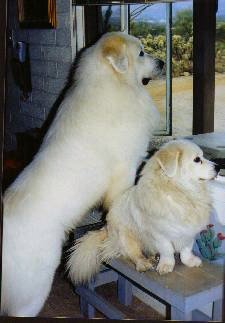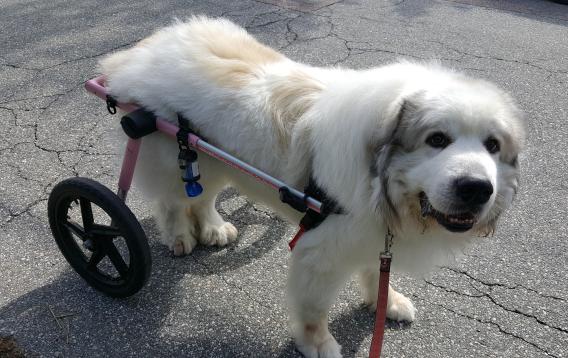Dwarfism

Click to view submission information
Dwarfism (chondrodysplasia) in the Great Pyrenees was first reported nearly 30 years ago. Puppies appear normal at birth, but by 14 days of age, affected dogs are obviously disproportionate, with shorter limbs, trunk, and muzzle compared to their normal littermates.
As adults, affected dogs range in size from 13 - 18 in. (33 - 46 cm) at the shoulder and weigh from 35 - 50 lbs. (15 to 23 kg). Some degree of hearing loss is frequently observed. Owners also report that affected dogs require frequent dentals and tooth extraction due to crowding. Both male and female dwarves appear to have reduced fertility.
Radiographic (x-ray) abnormalities are restricted to the metaphyses (region where bone growth occurs) of the long bones and the vertebrae.
This form of chondrodysplasia is not similar to those described in other breeds, such as CDPA and CDDY explained by two independent retrogene insertions of functional fibroblast growth factor 4 (FGF4).
Research carried out at the University of Minnesota, in collaboration with Purdue University, indicates that dwarfism in the Great Pyrenees is inherited in a simple autosomal recessive manner. We now offer a genetic test which allows owners to determine their dog’s status for this mutation (clear, carrier, or affected) in order to guide future breeding decisions. Carrier dogs need not be removed from the breeding population; however, they should only be bred to clear mates to avoid producing affected offspring.
Neuronal Degeneration (NDG)

An inherited neurological disease termed Neuronal Degeneration (NDG), has been reported in Great Pyrenees dogs. The age-of-onset of this disease is very young, well before an affected dog’s first birthday, but begins quite mildly. Initial signs include slipping, sliding, and difficulty maneuvering on smooth surfaces. The gait is abnormal - the dog may seem weak, clumsy, or uncoordinated. Over time, these problems progress and worsen. The abnormalities are most pronounced in the hind limbs, and both sides of the body tend to be affected symmetrically. Eventually, affected dogs display a wide-base stance, become unable to negotiate stairs, have a generalized loss of control and coordination over body movements, and may experience intermittent falling. The condition itself is non-painful, although stumbling and falling can obviously cause pain and traumatic injuries.
Necropsy of the neurological system reveals pathological changes throughout (in the brain, spinal cord, and peripheral nerves). The disease will continue to progress until the dog may not be able to support its own weight or walk on its own.
Research carried out at the University of Minnesota indicates that this disease is inherited in an autosomal recessive manner. We have identified a mutation within a disease-associated gene, and all affected dogs have two copies of this mutation. We are now offering a genetic test which allows owners to determine their dog’s status for this mutation in order to diagnose affected dogs and to guide future breeding decisions.
Videos of NDG progression
Submitting a sample
Step 1 - Select instructions for your sample type
- Blood sample protocol (pdf)
- Cheek swab protocol (pdf)
- Semen sample protocol (pdf)
Step 2 - Complete your submissions form(s)
Step 3 - Fees & Payment
Any single test (Dwarfism or NDG)
- 1-3 Dogs - $65 each
- 4 or more - $58 each
Dwarfism + NDG "combo" test
- 1-3 Dogs - $100 each
- 4 or more - $85 each
Need cheek swabs?
Cheek swabs are not included in the purchase price. Links to several purchasing options are available within the cheek swab protocol (pdf).
Step 4 - Ship your sample(s)
Result interpretation
Scientific references
A SACS deletion variant in Great Pyrenees dogs causes autosomal recessive neuronal degeneration.
Ekenstedt, K.J., Minor, K.M., Shelton, G.D. et al. Hum. Genet. (2023). https://doi.org/10.1007/s00439-023-02599-1
Chondrodysplasia in five Great Pyrenees
Bingel SA, Sande RD., et al. (1994)
J Am Vet Med Assoc. 1994 Sep 15;205(6):845-8. PMID: 7829378.